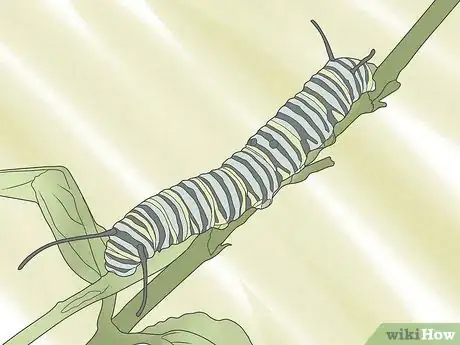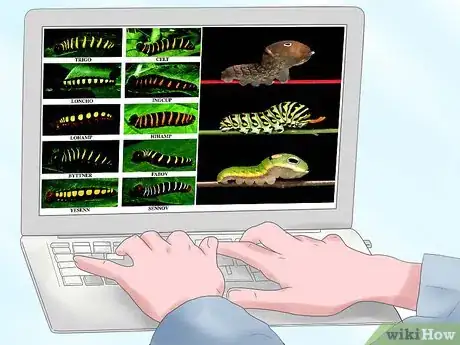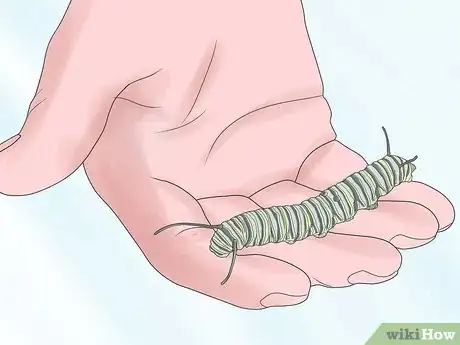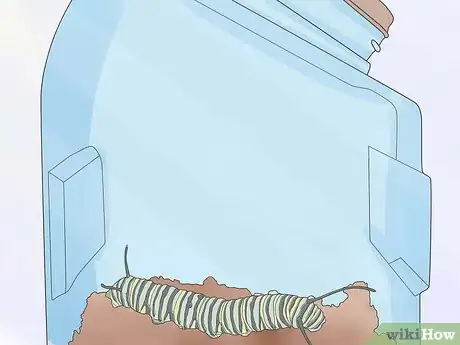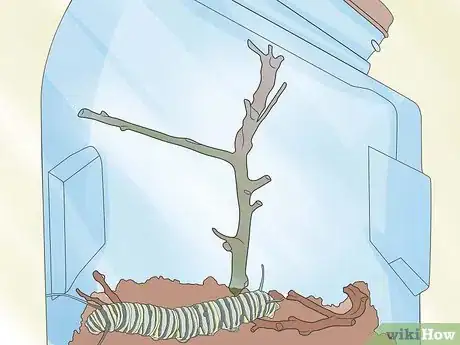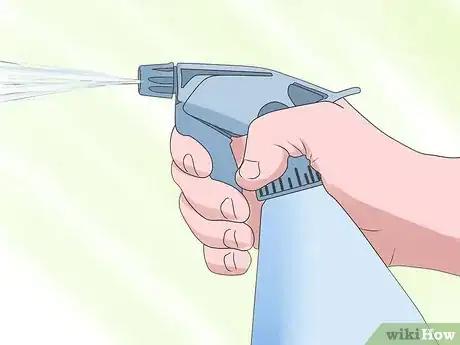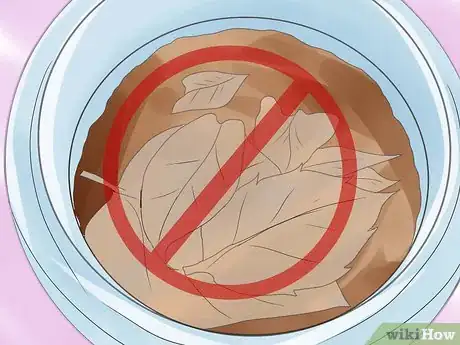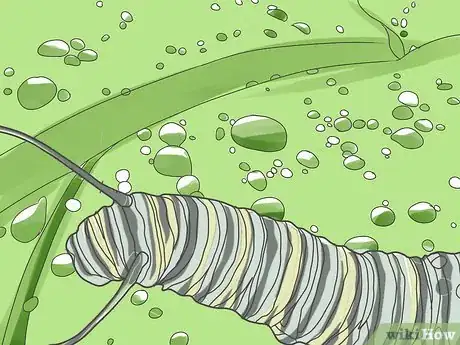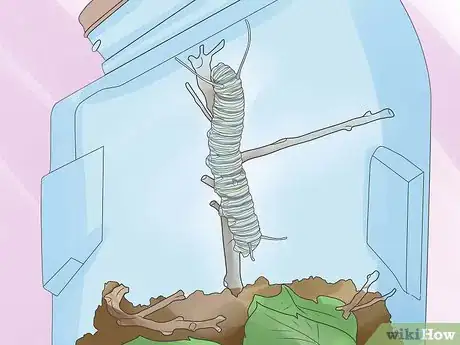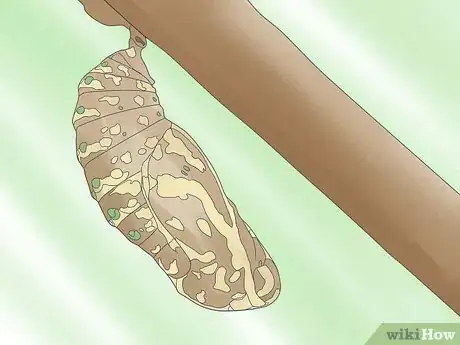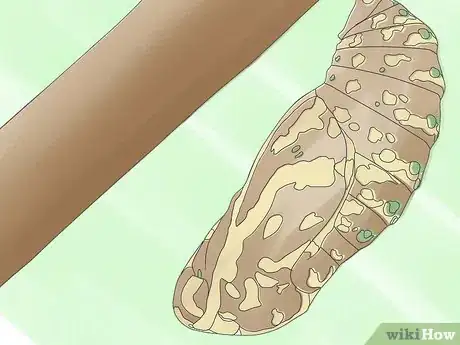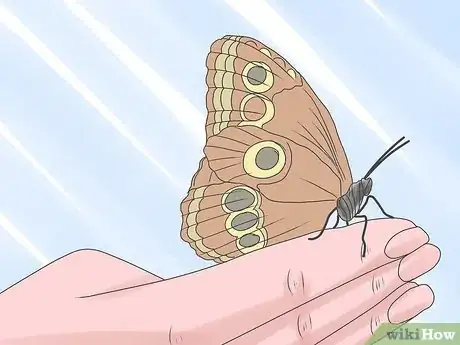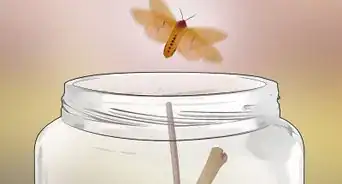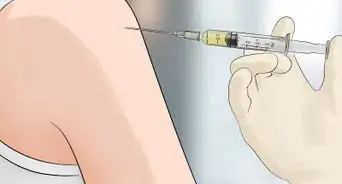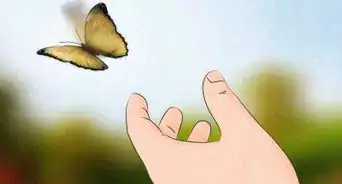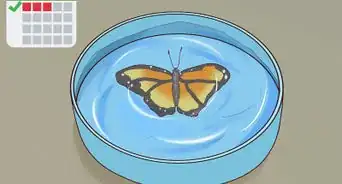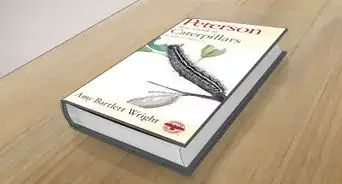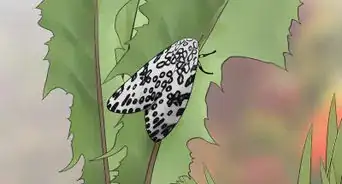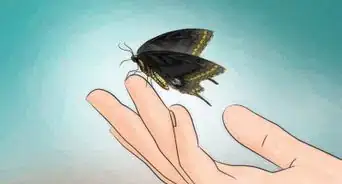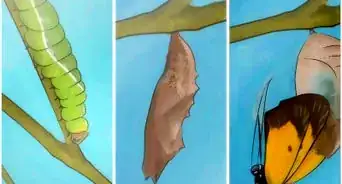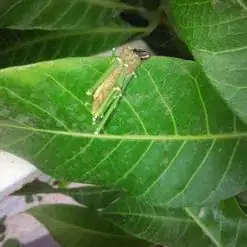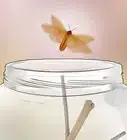This article was co-authored by Samuel Ramsey, PhD. Dr. Samuel Ramsey is an Entomologist and a researcher with the United States Department of Agriculture. Dr. Ramsey has extensive knowledge of symbiosis and specializes in insect disease spread, parasite behavior, mutualism development, biological control, invasive species ecology, pollinator health, and insect pest control. He holds a Bachelor’s degree in Entomology from Cornell University and a Ph.D. in Entomology from the University of Maryland. Dr. Ramsey’s research on bees has enabled researchers to develop targeted control techniques to restore honey bee populations worldwide. He also hosts a YouTube series called “Dr. Buggs.”
wikiHow marks an article as reader-approved once it receives enough positive feedback. This article received 43 testimonials and 88% of readers who voted found it helpful, earning it our reader-approved status.
This article has been viewed 705,266 times.
Caterpillars make great, easy pets for kids and adults alike. As long as you provide them with enough to eat, they require relatively little effort to take care of. And the best part? You get to watch the little critters wrap themselves up in an intricate cocoon or chrysalis, then magically emerge days or weeks later as a beautiful butterfly or moth. What could be more rewarding than that? Keep reading to learn how to properly care for a caterpillar and transform it into a butterfly.
Steps
Finding Caterpillars
-
1Choose the right time of year. The best time to go caterpillar hunting is during the spring and summer, as this is when the majority of moths and butterflies will lay their eggs. However, some species - such as the woolly bear caterpillar - emerge in autumn. Winter is the only time of year when caterpillars cannot be found.
- In the wild, caterpillar typically have a 2% survival rate, which means that for every 100 eggs a female butterfly or moth lays, only two will survive to maturity.[1] This is due to the large number of predators who list caterpillars as a food source. Therefore, by keeping the caterpillar as a pet, you are giving it a much greater chance of survival.
- Be aware that autumn caterpillars will most likely pupate for the entire winter, so you'll have to wait a lot longer for the moth or butterfly to emerge than with spring or summer butterflies, which typically emerge within 2 to 3 weeks.
-
2Look for caterpillars on host plants.[2] The best place to search for caterpillars is on their host plants, as caterpillars will typically stay close to their food source. If you are not picky about the type of caterpillar you want to care for, you can check the leaves of any plant in your garden or at the park. However, if you are looking for specific caterpillars/butterflies/moths, you will need to target specific plants. Some of the most common ones are as follows:
- The caterpillars of Monarch butterflies are most commonly found on the Milkweed plant.
- The caterpillars of Spicebush Swallowtails are most commonly found on the Spicebush.
- The caterpillars of Zebra Swallowtails are most commonly found on the leaves of the Paw Paw tree.
- The caterpillars of Black Swallowtails are most commonly found on herbs such as parsley, dill and fennel.
- The caterpillars of Luna Moths are most commonly found on the leaves of Walnut and Sweet Gum trees.
- The caterpillars of Cecropia Moths, Viceroy butterflies and Red-Spotted Purple butterflies are most commonly found on the leaves of Cherry Trees.[3]
Advertisement -
3Order specific species of caterpillar online. If there's a very specific type of caterpillar, butterfly or moth you want to care for, or if you're having difficulty finding a caterpillar outside, there is always the option to order caterpillars from special supplier, or buy butterfly kits online.
- You can purchase caterpillars or order them in their larvae state, before they have even hatched. If you're just interested in the butterflies or moths, you can order pupae - then all you need to do is wait for them to emerge.
- Some of the most commonly available caterpillars are Monarchs, which are available to order at www.MonarchWatch.org, and Painted Lady caterpillars. The Painted Lady caterpillars are particularly easy to keep, as they are delivered with a growth medium which sustains them until they pupate, eliminating the need to find their host plant.[3]
-
4Handle caterpillars with care. Once you find a caterpillar, it is very important that you handle it using the correct method. If you try to pick up a caterpillar, it can cling to the surface it's standing on with remarkable strength and if you continue to pull you may injure it, or even pull off its legs.
- The best way to pick up and transport a caterpillar is to take a sheet of paper or a leaf and place it in front of the caterpillar. Then give the caterpillar a little nudge on the behind. The caterpillar will then walk forwards onto the leaf or paper, in order to avoid your touch. You can then carry the caterpillar around on its temporary perch.
- Just make sure not to drop the caterpillars - dropping them from a height of even a few inches can kill them.
- If you need to handle the caterpillar, it is best to wash your hands first. Caterpillars are very fragile and can pick up bacterial infections from human skin.
- Some caterpillars have prickly hairs or spikes which can irritate or even sting your skin. Therefore, it's best to avoid touching these types of caterpillars with your bare hands.[4]
Housing Caterpillars
-
1Keep your caterpillar in a suitable container. Caterpillars don't need to be housed in anything too fancy - a clean one-gallon jar or a small fish tank is perfect.[5] These will be easy to clean and will allow you to see your caterpillar easily.
- Cover the container with a piece of cheesecloth or mesh and secure with a rubber band. This will allow proper ventilation. Don't just poke holes in a screw-on lid (as some sites advise) as the caterpillars may attempt to escape through these holes and injure themselves on the sharp edges.
- If you're housing more than one caterpillar, just make sure that each caterpillar has around three times it's body size in extra space to move around in.[6] This will prevent overcrowding.
-
2Line the base of the container with paper towel or soil. It's a good idea to line the bottom of your caterpillar's home with some paper towel or tissue paper. This will soak up any excess moisture and catch any caterpillar droppings (known as frass). You can then easily clean the container by whipping out the dirty paper and replacing it with fresh stuff.[7]
- However, you should only line your caterpillar container with paper towels if you know that you have a species of caterpillar which pupates above ground.
- If you have a species of caterpillar which pupates underground (or if you're not sure what species it is) you should line the bottom of the container with a two-inch layer of soil or sand. This way, the caterpillar has something to bury into.
- The soil or sand should be slightly damp - but not damp enough that it causes condensation on the sides of the container. Caterpillars are quite sensitive to humidity.[3]
-
3Place a couple of sticks in the container. It's a good idea to place a couple of sticks inside the caterpillars home, for a number of reasons:
- Firstly, the caterpillar will have something to climb on, which it may need to do in order to reach it's food.
- Secondly, the caterpillar may choose to pupate hanging from the stick. As a result, you should make sure that the stick is in a secure position and not in danger of falling over.
- Thirdly, once the butterfly or moth emerges from the pupa it will need somewhere to hang upside down in order to spread and dry its wings.
-
4Keep the container humid. Most caterpillars prefer a slightly humid environment. The best way to achieve this is to mist the container with a spray bottle of water every so often.
- However, you will need to be careful not to make the container damp either, as too much moisture can encourage the growth of mold inside the container and on the caterpillar itself.[3]
Feeding Caterpillars
-
1Find the caterpillar's host plant. A caterpillar's job is just to eat and eat and eat, so the most important part of caring for a caterpillar is to provide a constant supply of fresh food.
- The first thing to do is provide the caterpillar with some leaves from the plant or tree on which you found it, as there is a good chance that this is its host plant.
- Observe the caterpillar closely to see if eats the leaves you have provided. If it does - congratulations - you have found your caterpillar's host plant! Now all you need to do provide your caterpillar with a fresh supply of these leaves until it pupates.
-
2If you don't know what the host plant is, experiment with different types of leaves. Caterpillars are very picky eaters and each species has a limited number of plants it is willing to eat. In fact, most caterpillars will starve to death before they eat the wrong food. So if the caterpillar refuses the leaves from the plant you found it on, or you found the caterpillar somewhere other than on a plant, you will need to discover the correct food source through a process of trial and error.[8]
- The best thing to do in this situation is to gather a selection of different types of leaves from the place where you found the caterpillar and put them in its container. Then observe the caterpillar closely to see if it eats any of them. If it does, you can remove the other types of leaves and simply continue to provide the winning leaf.
- If you're having trouble finding a plant that the caterpillar will eat, it might be a good idea to consult a field guide such as Peterson First Guide to Caterpillars, or Caterpillars of Eastern Forests. These guides will match up caterpillar species with their favored food source, saving you a lot of time.[3]
- If you can't get your hands on these field guides, try some of the most common caterpillar food sources, as follows: cherry, oak, willow, alder, poplar, apple and birch. Also try providing the flowers as well as the leaves, as some caterpillars prefer this part of the plant.[4]
- If you simply cannot find the type of plant your caterpillar likes to eat, it may be best to release it in the same place where you found it. At least then it will have some chance of finding its own food source, otherwise it will probably starve.
-
3Keep the leaves fresh. Caterpillars will not eat old or dried out leaves, so it's very important that you provide them with a constant supply of fresh, green leaves. How often you need to provide new leaves will depend on the plant species - some will last up to a week, while others will need to be replaced everyday.
- A good way to prolong the life of the food supply is to place it in a glass jar of water inside the caterpillar's home.The water will keep the leaves fresh and green for longer.
- However, sometimes caterpillars can fall off the leaves into the glass jar and drown. To prevent this, stuff cotton wool or paper towel around the stems of the leaves. This will keep your caterpillar safe.[14]
- Alternatively, you can buy floral tubes very cheaply from a florist to place the leaves in. These have very narrow brims, decreasing the chance that your caterpillar will fall in.
- When you provide your caterpillar with new leaves, make sure to remove the old, dried out ones. Also make sure to keep the rest of the container clean, removing any caterpillar droppings or other debris.
- One more thing to be aware of is the possibility that spiders or other predators may be hiding amongst the leaves. If they are, they might eat your caterpillar once the leaves are placed in the container, which is the last thing you want! Therefore, you should make sure to examine all leaves and branches closely before placing them in the container.[15]
-
4Don't worry about giving your caterpillar water. Caterpillars don't need to drink - they get all the hydration they need from their food.
- However, if your caterpillar does happen to look a little dried out, or you want to raise the moisture levels in the container, try rinsing the leaves in water and placing them in the container without drying them.
- The droplets of water that remain on the leaves will provide any necessary moisture.
Turning Caterpillars Into Butterflies
-
1Don't worry if your caterpillar stops eating or becomes sluggish. Don't worry too much if your caterpillar suddenly stops eating, becomes sluggish or starts to change color - it is probably just preparing to molt or pupate, so this is completely normal behavior.
- The caterpillar may also become more active then usual, moving around its container continuously. If this is the case, it is probably just looking for a good place to pupate.
- Unfortunately, these behaviors may also be signs that the caterpillar is sick, so you should refrain from handling it at this time. Just wait to see if it successfully pupates.
- If you are keeping multiple caterpillars and one of them dies, remove the dead caterpillar from the container immediately. This will prevent any disease from spreading.[16]
-
2Make sure the pupa is hanging above ground. Once the caterpillar is ready it will pupate, thus beginning the process of turning into a moth or butterfly. Moth caterpillars will bury into the earth to make a cocoon, while butterfly caterpillars with enclose themselves in a chrysalis, hanging above ground.
- While the underground cocoons do not need any attention, you may need to move or re-hang the chrysalis if it is in an unsuitable location or of it falls from its original hanging spot.
- If you believe the chrysalis is in too tight a spot for the emerging butterfly to spread its wings, it may be best to move it. Handle the chrysalis very gently and hang it from a stick or attach it to the side of the container.
- You can do this by threading a piece of string through the pointy end of the chrysalis, or by sticking a small pin through it and hanging it from a suitable location. [17]
-
3Clean out the container and keep it humid. Once the pupa has formed, you should clean out the caterpillar container, removing any old food or waste. Even though the pupa is still alive, it does not require any food or water.
- Leave any sticks in the container when cleaning out. These will be necessary once the butterfly or moth emerges, as it will use the stick as a perch while it spreads its wings. If the butterfly or moth has nothing to perch on, its wings will not form properly and it will die.[18]
- Also try to keep the container humid by checking it every few days. If the the container is too dry the pupa will dry out, but if it is too moist the pupa can go moldy. Both of these things can prevent the butterfly/moth from emerging.
- If the soil at the bottom of the container feels very dry, mist it with some water. If you see any condensation forming on the sides of the container, wipe it off.[19]
- Consult a caterpillar/butterfly guide to find exact instructions regarding the optimum temperature and humidity for your species of pupa.
-
4Wait for the pupa to turn dark or clear. Now all that's left to do is wait! Some butterflies and moths will emerge after as little as eight days, while others may take several months or even years.
- If you caught your caterpillar in the fall, chance are it will spend the winter months in its pupa and only emerge in the spring - this process is known as "overwintering".
- Some telltale signs that a butterfly is getting ready to emerge from its chrysalis are the chrysalis turning darker in color, or even becoming clear.
- Keep a close eye on the chrysalis from this point on, as butterflies can emerge from their pupa in a matter of seconds and you don't want to miss it!
- As moth cocoons are underground, you will not be able to observe any changes.
- If the chrysalis turns a very dark color, this may be an indication that the pupa is dead. Test it by gently bending the pupa around the abdominal region - if it stays bent this is a good indication that the pupa is dead.[20]
-
5Release the butterfly. Once the butterfly or moth has magically emerged from its pupa, it will crawl up a stick and hang upside down until its wings dry out and unfold. This is a very important process and can take several hours.
- When the butterfly or moth begins to flutter its wings and starts flapping around the cage, it's time to release it. These creatures do not like to be confined and they can damage their wings if they are continually beating them against the sides of the container, trying to escape.[21]
- Take the container outside, to the location where you originally found the caterpillar, open the lid and let your butterfly happily fly away.
Community Q&A
Did you know you can get answers researched by wikiHow Staff?
Unlock staff-researched answers by supporting wikiHow
-
QuestionCan you touch a caterpillar?
 wikiHow Staff EditorThis answer was written by one of our trained team of researchers who validated it for accuracy and comprehensiveness.
wikiHow Staff EditorThis answer was written by one of our trained team of researchers who validated it for accuracy and comprehensiveness.
Staff Answer wikiHow Staff EditorStaff AnswerMost caterpillars are safe to handle but some can be dangerous to hold because they may trigger allergic reactions/anaphylactic shock or rashes, or they may sting or eject/ooze spiky hairs or even poisons. It is important to identify the caterpillar before attempting to touch or hold it; some, such as the puss caterpillar, hickory tussock or saddleback caterpillars can hurt you or make you very ill. Use a caterpillar guide or online images if you are not sure what the caterpillar is before handling it.
wikiHow Staff EditorStaff AnswerMost caterpillars are safe to handle but some can be dangerous to hold because they may trigger allergic reactions/anaphylactic shock or rashes, or they may sting or eject/ooze spiky hairs or even poisons. It is important to identify the caterpillar before attempting to touch or hold it; some, such as the puss caterpillar, hickory tussock or saddleback caterpillars can hurt you or make you very ill. Use a caterpillar guide or online images if you are not sure what the caterpillar is before handling it. -
QuestionCan you get the pesticide out of milkweed that's been treated for pests? Worried about the Monarchs.
 wikiHow Staff EditorThis answer was written by one of our trained team of researchers who validated it for accuracy and comprehensiveness.
wikiHow Staff EditorThis answer was written by one of our trained team of researchers who validated it for accuracy and comprehensiveness.
Staff Answer wikiHow Staff EditorStaff AnswerOnce milkweed has been treated with pesticide, it becomes toxic to insects, including the Monarch caterpillars that use it as a food source. The pesticide needs time to dissipate, usually months, during which time the plant either needs to be covered with netting or similar, or if in a pot, moved indoors so that Monarch butterflies will not try to lay their eggs on it. Remove caterpillars already on it and place them on safe foliage; they may or may not survive but at least you're given them a chance.
wikiHow Staff EditorStaff AnswerOnce milkweed has been treated with pesticide, it becomes toxic to insects, including the Monarch caterpillars that use it as a food source. The pesticide needs time to dissipate, usually months, during which time the plant either needs to be covered with netting or similar, or if in a pot, moved indoors so that Monarch butterflies will not try to lay their eggs on it. Remove caterpillars already on it and place them on safe foliage; they may or may not survive but at least you're given them a chance. -
QuestionDo caterpillars need to drink water?
 wikiHow Staff EditorThis answer was written by one of our trained team of researchers who validated it for accuracy and comprehensiveness.
wikiHow Staff EditorThis answer was written by one of our trained team of researchers who validated it for accuracy and comprehensiveness.
Staff Answer wikiHow Staff EditorStaff AnswerLike many living creatures, water is an essential part of a caterpillar’s diet. However the caterpillar gets its water from what it eats rather than drinking it from a pool or container of water. If you think a caterpillar you’re keeping looks a little dehydrated, spray the leaves with water before adding them; the droplets left on the leaves will be sufficient for the caterpillar. Always give the caterpillars quality foliage to eat; there is no need to add a small container of water to the caterpillar enclosure (in fact it might harm the caterpillar if it falls into the water).
wikiHow Staff EditorStaff AnswerLike many living creatures, water is an essential part of a caterpillar’s diet. However the caterpillar gets its water from what it eats rather than drinking it from a pool or container of water. If you think a caterpillar you’re keeping looks a little dehydrated, spray the leaves with water before adding them; the droplets left on the leaves will be sufficient for the caterpillar. Always give the caterpillars quality foliage to eat; there is no need to add a small container of water to the caterpillar enclosure (in fact it might harm the caterpillar if it falls into the water).
Warnings
- Do not handle them improperly because some caterpillars will bite or sting you if they are not held properly.⧼thumbs_response⧽
- Be careful what you feed it. Some plants that are eaten by certain kinds will poison others.⧼thumbs_response⧽
References
- ↑ https://butterfly-fun-facts.com/only-1-or-2-butterfly-eggs-out-of-100-live-to-become-adult-butterflies/
- ↑ https://www.nationaltrust.org.uk/features/no-38-bring-up-a-butterfly
- ↑ 3.03.13.23.33.43.53.63.7http://www.butterflyschool.org/teacher/raising.html
- ↑ 4.04.14.2http://insects.about.com/od/keepingliveinsects/ss/rearingcats.htm
- ↑ https://www.butterfliesandmoths.org/faq/how-can-i-raise-caterpillar-adult-stage
- ↑ https://www.keepinginsects.com/butterfly/care/
- ↑ https://www.nationaltrust.org.uk/features/no-38-bring-up-a-butterfly
- ↑ https://animals.mom.me/how-to-care-for-a-caterpillar-in-a-jar-until-it-becomes-a-butterfly-12182114.html
- ↑ 10.010.1http://www.keepinginsects.com/butterfly/care/
About This Article
To care for a caterpillar, start by making it a home in a small jar or fish tank by lining the bottom with damp soil and a few sticks. Once you’ve put the caterpillar in the container, cover the top with cheesecloth or mesh, so that it can’t get out, but air can get in. Next, feed your caterpillar fresh leaves, making sure to replace any leaves that get shriveled or dried out. If you don’t know which kind of leaves to use, try picking some from the plant you found the caterpillar on or do research online to see what kind of leaves that species eats. For tips on how to know when your caterpillar is getting ready to turn into a butterfly, read on!

